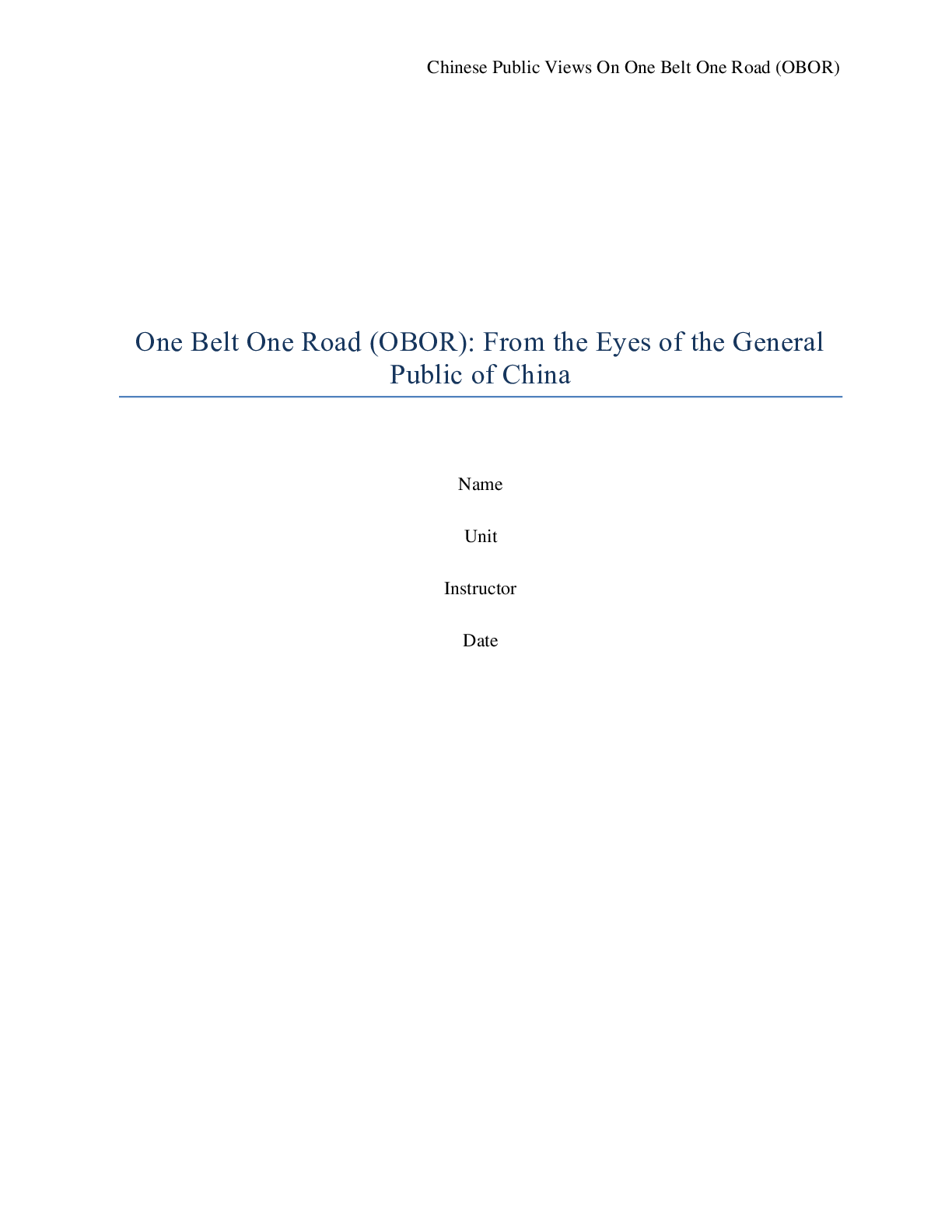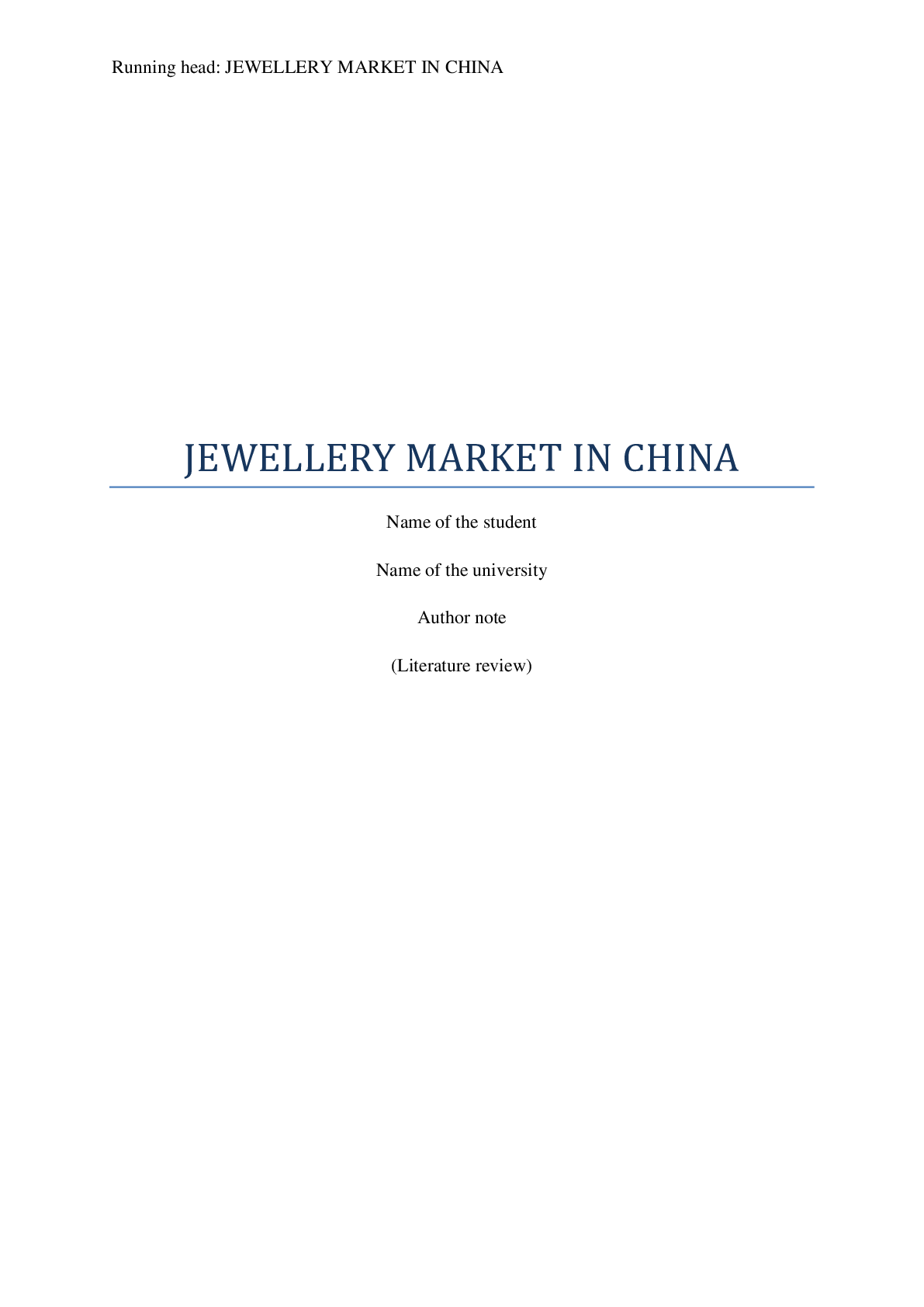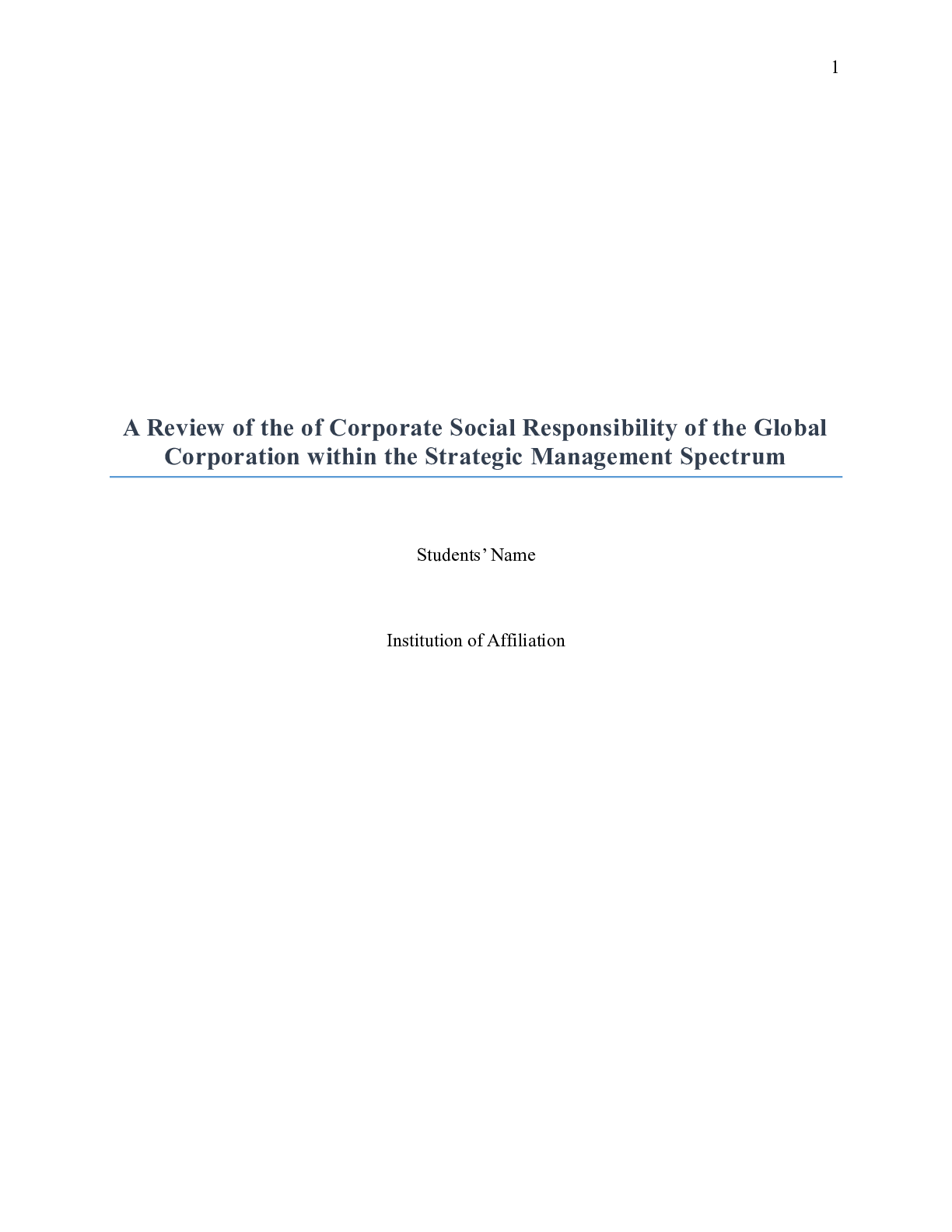Business Research > Dissertation > The impact of social media advertising of luxury goods on 18-25 years old young consumer’s purchas (All)
The impact of social media advertising of luxury goods on 18-25 years old young consumer’s purchase intention in Chinese Market: Dissertation.
Document Content and Description Below
The impact of social media advertising of luxury goods on 18-25 years old young consumer’s purchase intention in Chinese Market Aim of the Study The research study emphasises explicitly on gaining... a better understanding regarding the expectations and perceptions of young Chinese consumers on the luxury goods in a reference of social media. The survey of the research also aims in establishing how the presence of a specific luxury good presence on the social media is perceived by different potential consumers within the age group 18-20, attempting to prolifically investigate and analyse the social media value for luxury goods. The research also focuses on how social media advertising impacts on luxury goods and how the purchase intentions of the Chinese consumers are impacted. Research Objectives For assessing the issue mentioned above, this specific research proposal will emphasise only on luxury goods that simplified the procedure and allows in-depth analysis of the topic and enable in highlighting the significant factors. Firstly, as the consumers are fundamentally involved in a different environment where the trends are always changing, it is quite essential to re-investigate the critical motivations that drive the young consumers of China in buying the goods of different luxury brand and whether the distinctive changes have reflected in the communication of social media marketing from the perspective of the consumers. On the other hand, the options of the young consumers regarding the luxury brands social media marketing and their attitudes will be investigated. Finally how the social media affect the Chinese consumers purchase intention towards luxury products will be examined. Research Questions For the significant purpose of assessing the chosen topic, the impact of social media advertising of luxury goods on 18-25 years old young consumers' purchase intention in Chinese market the list of following questions have been taken into consideration. The below-mentioned questions were specially formulated to give direction to analyse the entire research aspects better. • How do the young consumers perceive luxury goods on social media? • How does social media advertising of luxury goods impact the purchase intention of the young consumers in the Chinese market? • Does the regular and continuous social media useable to attract the attention of the young consumers? • Does the study highlight the difference in the perception of luxury? References Annie Jin, S. A. (2012). The potential of social media for luxury brand management. Marketing Intelligence & Planning, 30(7), 687-699. Annie Jin, S. A. (2012). The potential of social media for luxury brand management. Marketing Intelligence & Planning, 30(7), 687-699. Atwal, G., & Williams, A. (2009). Luxury brand marketing–the experience is everything!. Journal of Brand Management, 16(5-6), 338-346. Bolton, R. N., Parasuraman, A., Hoefnagels, A., Migchels, N., Kabadayi, S., Gruber, T., ... & Solnet, D. (2013). Understanding Generation Y and their use of social media: a review and research agenda. Journal of service management, 24(3), 245-267. Chan, K. W., & Li, S. Y. (2010). Understanding consumer-to-consumer interactions in virtual communities: The salience of reciprocity. Journal of Business Research, 63(9-10), 1033-1040. Chiu, C., Ip, C., & Silverman, A. (2012). Understanding social media in China. McKinsey Quarterly, 2(2012), 78-81. Chu, S. C., & Choi, S. M. (2011). Electronic word-of-mouth in social networking sites: A cross-cultural study of the United States and China. Journal of Global Marketing, 24(3), 263-281. Chu, S. C., & Kim, Y. (2011). Determinants of consumer engagement in electronic word-of-mouth (eWOM) in social networking sites. International journal of Advertising, 30(1), 47-75. Chu, S. C., Kamal, S., & Kim, Y. (2013). Understanding consumers' responses toward social media advertising and purchase intention toward luxury products. Journal of Global Fashion Marketing, 4(3), 158-174. Daugherty, T., & Hoffman, E. (2014). eWOM and the importance of capturing consumer attention within social media. Journal of Marketing Communications, 20(1-2), 82-102. Dwivedi, Y.K., Kapoor, K.K. and Chen, H., 2015. Social media marketing and advertising. The Marketing Review, 15(3), pp.289-309. Ehrenberg, A., Juckes, S., White, K. M., & Walsh, S. P. (2008). Personality and self-esteem as predictors of young people's technology use. Cyberpsychology & behavior, 11(6), 739-741. Faure, G. O., & Fang, T. (2008). Changing Chinese values: Keeping up with paradoxes. International business review, 17(2), 194-207. Felix, R., Rauschnabel, P.A. and Hinsch, C., 2017. Elements of strategic social media marketing: A holistic framework. Journal of Business Research, 70, pp.118-126. Gao, L., Norton, M. J., Zhang, Z. M., & Kin-man To, C. (2009). Potential niche markets for luxury fashion goods in China. Journal of Fashion Marketing and Management: An International Journal, 13(4), 514-526. Gao, T., Sultan, F., & Rohm, A. J. (2010). Factors influencing Chinese youth consumers' acceptance of mobile marketing. Journal of Consumer Marketing, 27(7), 574-583. Godey, B., Manthiou, A., Pederzoli, D., Rokka, J., Aiello, G., Donvito, R., & Singh, R. (2016). Social media marketing efforts of luxury brands: Influence on brand equity and consumer behavior. Journal of business research, 69(12), 5833-5841. Godey, B., Manthiou, A., Pederzoli, D., Rokka, J., Aiello, G., Donvito, R. and Singh, R., 2016. Social media marketing efforts of luxury brands: Influence on brand equity and consumer behavior. Journal of business research, 69(12), pp.5833-5841. Goodrich, K., & De Mooij, M. (2014). How ‘social’are social media? A cross-cultural comparison of online and offline purchase decision influences. Journal of Marketing Communications, 20(1-2), 103-116. Guo, S., Wang, M., & Leskovec, J. (2011, June). The role of social networks in online shopping: information passing, price of trust, and consumer choice. In Proceedings of the 12th ACM conference on Electronic commerce (pp. 157-166). ACM. Han, Y. J., Nunes, J. C., & Drèze, X. (2010). Signaling status with luxury goods: The role of brand prominence. Journal of marketing, 74(4), 15-30. Kamal, S., Chu, S. C., & Pedram, M. (2013). Materialism, attitudes, and social media usage and their impact on purchase intention of luxury fashion goods among American and Arab young generations. Journal of Interactive Advertising, 13(1), 27-40. Kapferer, J. N., & Bastien, V. (2009). The specificity of luxury management: Turning marketing upside down. Journal of Brand Management, 16(5-6), 311-322. Kim, A. J., & Ko, E. (2010). Impacts of luxury fashion brand’s social media marketing on customer relationship and purchase intention. Journal of Global Fashion Marketing, 1(3), 164-171. Kim, A. J., & Ko, E. (2010). Impacts of luxury fashion brand’s social media marketing on customer relationship and purchase intention. Journal of Global Fashion Marketing, 1(3), 164-171. Kim, A. J., & Ko, E. (2012). Do social media marketing activities enhance customer equity? An empirical study of luxury fashion brand. Journal of Business Research, 65(10), 1480-1486. Liang, T. P., & Turban, E. (2011). Introduction to the special issue social commerce: a research framework for social commerce. International Journal of electronic commerce, 16(2), 5-14. Lu, P. X. (2011). Elite China: luxury consumer behavior in China. John Wiley & Sons. Mostafa, M. M. (2013). More than words: Social networks’ text mining for consumer brand sentiments. Expert Systems with Applications, 40(10), 4241-4251. Naylor, R. W., Lamberton, C. P., & West, P. M. (2012). Beyond the “like” button: The impact of mere virtual presence on brand evaluations and purchase intentions in social media settings. Journal of Marketing, 76(6), 105-120. Ngai, J., & Cho, E. (2012). The young luxury consumers in China. Young Consumers, 13(3), 255-266. Okonkwo, U. (2009). Sustaining the luxury brand on the Internet. Journal of brand management, 16(5-6), 302-310. Park, N., Kee, K. F., & Valenzuela, S. (2009). Being immersed in social networking environment: Facebook groups, uses and gratifications, and social outcomes. CyberPsychology & Behavior, 12(6), 729-733. Silverstein, M. J., Fiske, N., & Butman, J. (2008). Trading Up: why consumers want new luxury goods--and how companies create them. Penguin. Solomon, M. R., Dahl, D. W., White, K., Zaichkowsky, J. L., & Polegato, R. (2014). Consumer behavior: Buying, having, and being (Vol. 10). London: Pearson. Stephen, A. T., & Toubia, O. (2010). Deriving value from social commerce networks. Journal of marketing research, 47(2), 215-228. Truong, Y. (2010). Personal aspirations and the consumption of luxury goods. International Journal of Market Research, 52(5), 655-673. Truong, Y., & McColl, R. (2011). Intrinsic motivations, self-esteem, and luxury goods consumption. Journal of Retailing and Consumer Services, 18(6), 555-561. Tsai, W. S., Yang, Q., & Liu, Y. (2013). Young Chinese consumers’ snob and bandwagon luxury consumption preferences. Journal of International Consumer Marketing, 25(5), 290-304. Wang, X., Yu, C., & Wei, Y. (2012). Social media peer communication and impacts on purchase intentions: A consumer socialization framework. Journal of interactive marketing, 26(4), 198-208. Wang, Y., Sun, S., Lei, W., & Toncar, M. (2009). Examining beliefs and attitudes toward online advertising among Chinese consumers. Direct Marketing: An International Journal, 3(1), 52-66. Wiedmann, K. P., Hennigs, N., & Siebels, A. (2009). Value‐based segmentation of luxury consumption behavior. Psychology & Marketing, 26(7), 625-651. Wiedmann, K. P., Hennigs, N., & Siebels, A. (2009). Value‐based segmentation of luxury consumption behavior. Psychology & Marketing, 26(7), 625-651. Wilcox, K., Kim, H. M., & Sen, S. (2009). Why do consumers buy counterfeit luxury brands?. Journal of marketing research, 46(2), 247-259. Zeng, F., Huang, L., & Dou, W. (2009). Social factors in user perceptions and responses to advertising in online social networking communities. Journal of interactive advertising, 10(1), 1-13. Zhao, X., & Belk, R. W. (2008). Politicizing consumer culture: Advertising's appropriation of political ideology in China's social transition. Journal of Consumer Research, 35(2), 231-244. Zhou, L. and Wang, T., 2014. Social media: A new vehicle for city marketing in China. Cities, 37, pp.27-32. Online articles Wang, F., Zheng, P., Freeman, B. and Chapman, S., 2015. Chinese tobacco companies’ social media marketing strategies. Tobacco control, 24(4), pp.408-409.<<https://tobaccocontrol.bmj.com/content/24/4/408.short> [Accesed on 25/5/2018] [Show More]
Last updated: 2 years ago
Preview 1 out of 43 pages

Buy this document to get the full access instantly
Instant Download Access after purchase
Buy NowInstant download
We Accept:

Reviews( 0 )
$14.00
Can't find what you want? Try our AI powered Search
Document information
Connected school, study & course
About the document
Uploaded On
Jul 10, 2020
Number of pages
43
Written in
Additional information
This document has been written for:
Uploaded
Jul 10, 2020
Downloads
0
Views
174








